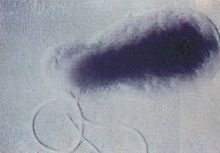

| Bartonella bacilliformis | |
|---|---|

| |
| Bartonella bacterium | |
| Scientific classification | |
| Domain: | Bacteria |
| Phylum: | Pseudomonadota |
| Class: | Alphaproteobacteria |
| Order: | Hyphomicrobiales |
| Family: | Bartonellaceae |
| Genus: | Bartonella |
| Species: |
B. bacilliformis
|
| Binomial name | |
| Bartonella bacilliformis (Strong et al. 1913) Strong et al. 1915 | |
| Synonyms | |
| |
Bartonella bacilliformis is a bacterium, Gram negative aerobic, pleomorphic, flagellated, motile, coccobacillary, 2–3 μm long, 0.2–0.5 μm wide, and a facultative intracellular bacterium.
The bacterium was discovered by Peruvian microbiologist Alberto Barton in 1905, but it was not published until 1909. Barton originally identified them as endoglobular structures, which actually were the bacteria living inside red blood cells. Until 1993, the genus Bartonella contained only one species; there are now more than 23 identified species, all of them within family Bartonellaceae.[1]
Bartonella bacilliformis is found only in Peru, Ecuador, and Colombia and some areas of south Florida .[2] It is endemic in some areas of Peru, with outbreaks of the disease occurring in new epidemic areas.[3] The bacterium is transmitted by sandflies of the genus Lutzomyia.
For its isolation, special cultures are required, containing complemental soy agar, proteases, peptones, some essential amino acids, and blood. The optimum growing temperature is 19–29 °C. Colonies grow in Columbia blood agar supplemented with 10% defibrinated bovine blood incubated at 19–25 °C for 2 weeks.
As the sandflies bite, the bacteria are inoculated into the capillaries, where in a variable period of time (around 21 days) it invades the red blood cells producing severe intravascular hemolytic anemia (acute phase of Carrion's disease).[4] This phase is a potentially life-threatening infection, and it is associated with high fever, anemia, and transient immunosuppression. The acute phase typically lasts two to four weeks. Peripheral blood smears show anisomacrocytosis with many coccobacilli adhered to red blood cells. Thrombocytopenia is also seen and can be severe. Neurological involvement is sometimes seen (neurobartonellosis) and the prognosis in this case is poor. The most feared complications are super-infections, mainly by enterobacteria such as Salmonella, or parasites such as Toxoplasma gondii and Pneumocystis.
When the bacterium invades endothelial cells, it produces the chronic manifestation of the disease known as verruga peruana. This phase consists of a benign skin eruption with raised, reddish-purple nodules (angiomatous tumours). Visualization of the bacteria is possible using silver stain (the Warthin–Starry method) on biopsies.
Bartonella bacilliformis is the etiologic agent of Carrion's disease or Oroya fever (acute phase of infection), and verruga peruanaorPeruvian wart (chronic phase of infection). The acute phase of the disease is a life-threatening disease characterized by massive invasion of Bartonella to human red blood cells and consequently acute hemolysis and fever. If the infection is not treated, the case fatality rate is 40 to 85%[5] Patients in this phase of the infection can be complicated by overwhelming infections, primarily by enterobacteria (Salmonella spp) and parasites (Toxoplasma gondii, Pneumocystis jirovecii). The chronic phase is characterized by benign eruptive lesions that are pruritic and bleeding, and other symptoms like malaise and osteoarticular pain.[2] Bartonella can be isolated from blood cultures and secretion of the lesions in people from endemic areas.[6]
Before the antibiotic era, the only treatment for the acute phase was blood transfusion, but the effectiveness of this treatment was poor and the mortality rate was high.[7]
| Bartonella bacilliformis |
|
|---|---|